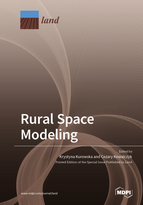Rural Space Modeling
A special issue of Land (ISSN 2073-445X).
Deadline for manuscript submissions: closed (30 September 2021) | Viewed by 33472
Special Issue Editors
Interests: rural areas; sustainability; spatial planning; land use change; land use modelling; environmental analysis; urbanization
Interests: urban analysis; land use/cover change; land use modelling; statistical approaches; real estate market
Special Issue Information
Dear Colleagues,
Rural areas play a very important role in social life and the economy. They provide residence and employment as well as recreational sites enabling visitors to enjoy unspoiled nature. Rural areas not only supply raw materials and products, but they also provide space for other functions. Spatial planning plays a very important role in the process of rural space modelling. It is also important to study the local and external conditions. A rural development framework can be proposed based on an evaluation of the observed phenomena. The following list provides some examples of topics of interest to ensure the consistency of the papers in this Special Issue:
- Spatial planning;
- Spatial order;
- Institutional efficiency;
- Spatial, financial, and environmental effects of planning studies;
- Urbanization of rural areas;
- Town–village relationships;
- Social, cultural, economic, environmental, and spatial aspects of rural development.
Dynamically growing new technologies (e.g., multi-criteria methods, GIS tools) are gaining popularity all over the world as tools for spatial analysis. This Special Issue focuses on the practice and theory of the application of modern technologies in rural space modelling and rural area development planning.
Authors are invited to submit papers on modern research directions of rural space modelling in such domains as spatial planning, spatial order, spatiotemporal analysis, land use change, or environmental aspects, etc. The integration of different data, GIS tools, and modelling can provide valuable support to rural space modelling and decision-making.
Papers incorporating novel and interesting techniques in studying these aspects, as well as some interesting applications, will be considered. Well-prepared review papers are also welcome. We invite all prospective authors to share their research.
Dr. Krystyna Kurowska
Dr. Cezary Kowalczyk
Guest Editors
Manuscript Submission Information
Manuscripts should be submitted online at www.mdpi.com by registering and logging in to this website. Once you are registered, click here to go to the submission form. Manuscripts can be submitted until the deadline. All submissions that pass pre-check are peer-reviewed. Accepted papers will be published continuously in the journal (as soon as accepted) and will be listed together on the special issue website. Research articles, review articles as well as short communications are invited. For planned papers, a title and short abstract (about 100 words) can be sent to the Editorial Office for announcement on this website.
Submitted manuscripts should not have been published previously, nor be under consideration for publication elsewhere (except conference proceedings papers). All manuscripts are thoroughly refereed through a single-blind peer-review process. A guide for authors and other relevant information for submission of manuscripts is available on the Instructions for Authors page. Land is an international peer-reviewed open access monthly journal published by MDPI.
Please visit the Instructions for Authors page before submitting a manuscript. The Article Processing Charge (APC) for publication in this open access journal is 2600 CHF (Swiss Francs). Submitted papers should be well formatted and use good English. Authors may use MDPI's English editing service prior to publication or during author revisions.
Keywords
- rural areas
- land use change
- spatial planning
- spatial order
- urbanization
- environmental protection
- aspects of rural development







